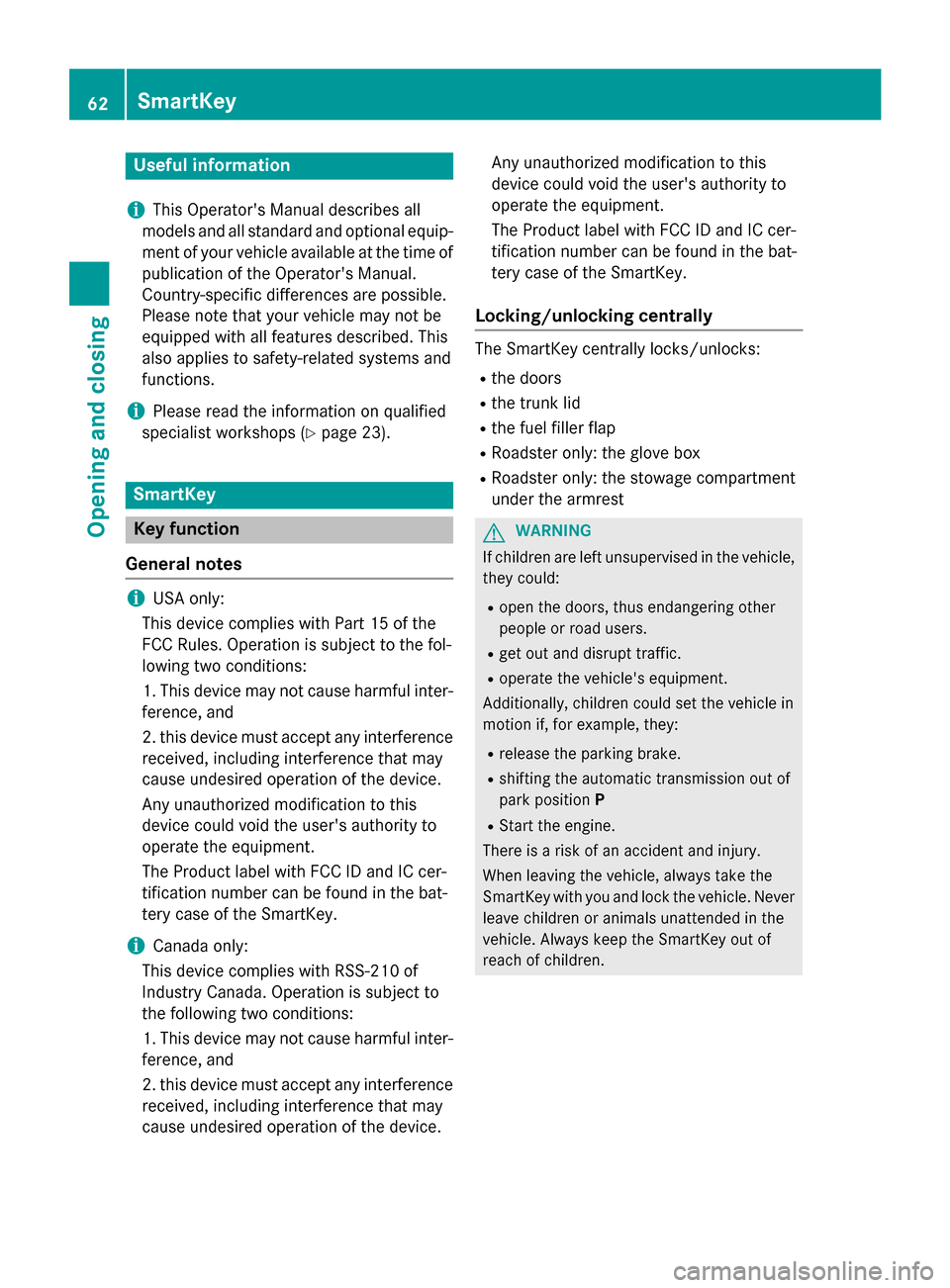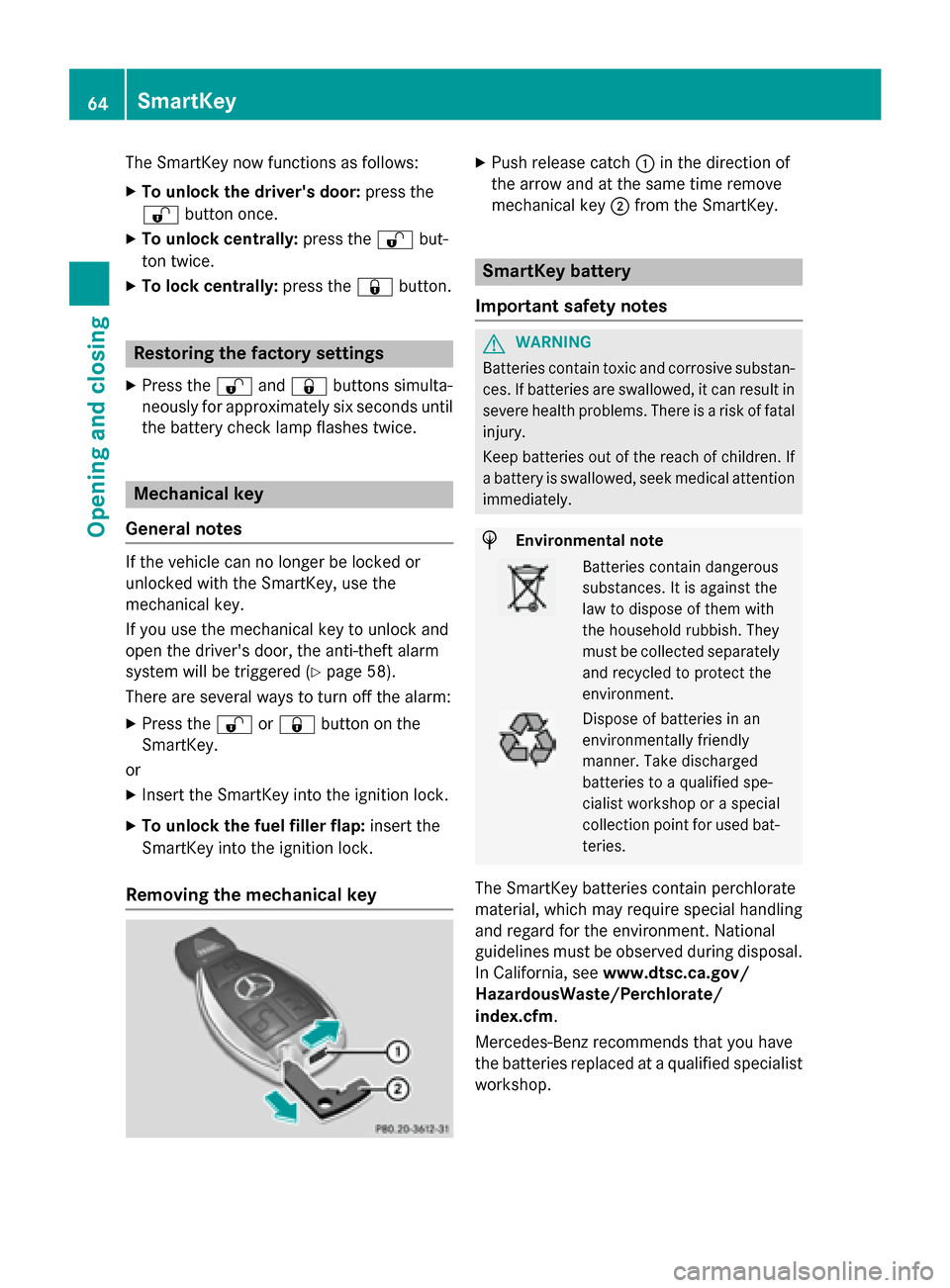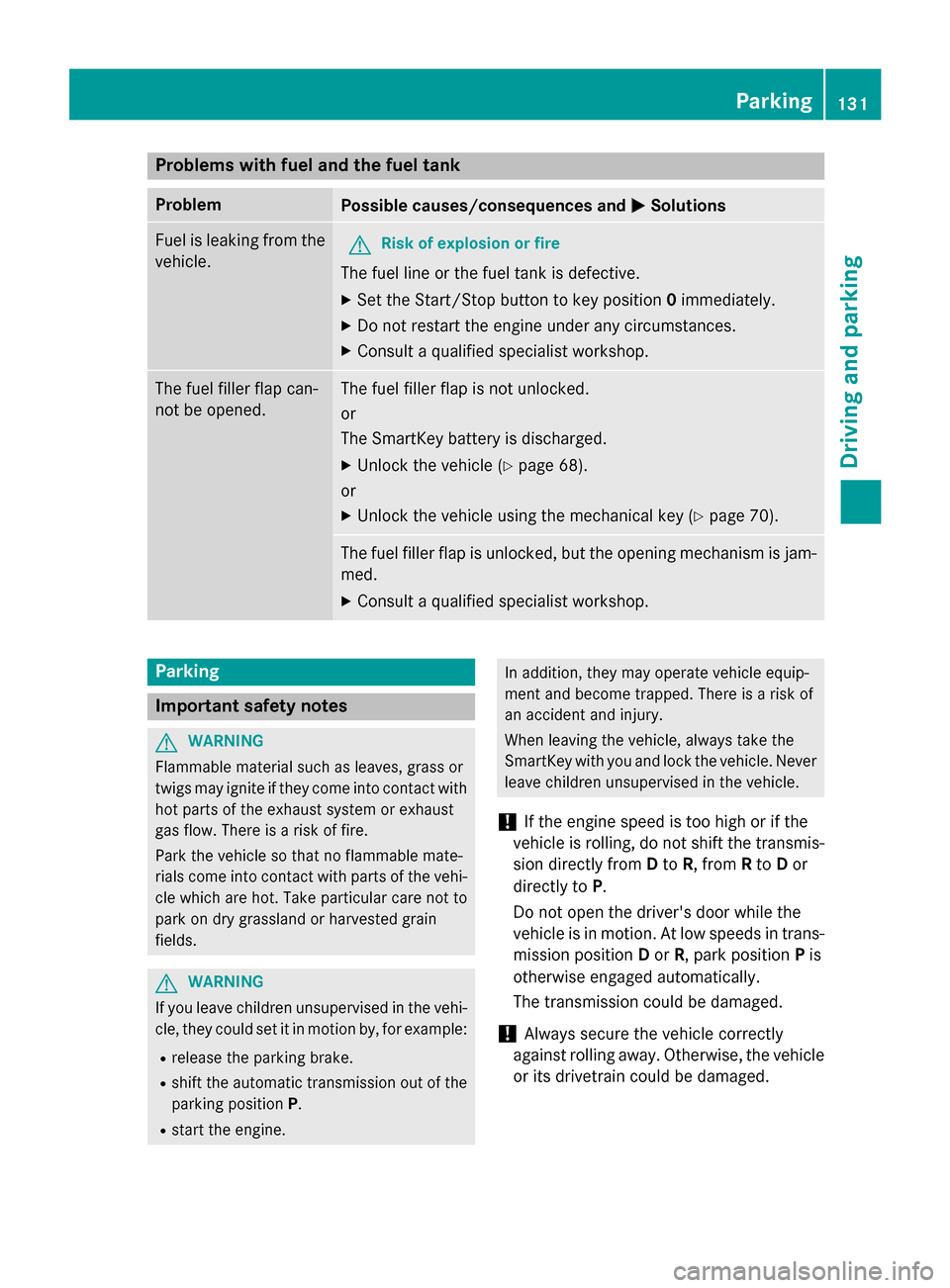Page 64 of 290

Useful information
i This Operator's Manual describes all
models and all standard and optional equip- ment of your vehicle available at the time of
publication of the Operator's Manual.
Country-specific differences are possible.
Please not ethat your vehicle may not be
equipped with all feature sdescribed. This
also applies to safety-related system sand
functions.
i Please read the information on qualified
specialist workshops (Y page 23).SmartKey
Key function
Genera lnotes i
USA only:
This device complies with Part 15 of the
FCC Rules. Operation is subjec ttothe fol-
lowing two conditions:
1. This device may not cause harmful inter-
ference, and
2. this device must accept any interference received, including interferenc ethat may
cause undesired operation of the device.
Anyu nauthorized modification to this
device could void the user's authorit yto
operate the equipment.
The Product label with FCC ID and IC cer-
tification number can be found in the bat-
ter yc ase of the SmartKey.
i Canada only:
This device complies with RSS-210 of
Industry Canada. Operation is subjec tto
the following two conditions:
1. This device may not cause harmful inter- ference, and
2. this device must accept any interference
received, including interferenc ethat may
cause undesired operation of the device. Anyu
nauthorized modification to this
device could void the user's authorit yto
operate the equipment.
The Product label with FCC ID and IC cer-
tification number can be found in the bat-
ter yc ase of the SmartKey.
Locking/unlocking centrally The SmartKey centrally locks/unlocks:
R the doors
R the trun klid
R the fuel filler flap
R Roadster only: the glove box
R Roadster only: the stowage compartment
under the armrest G
WARNING
If children are left unsupervised in the vehicle, they could:
R open the doors, thus endangering other
people or road users.
R get out and disrupt traffic.
R operate the vehicle' sequipment.
Additionally, children could set the vehicle in
motion if, for example, they:
R release the parkin gbrake.
R shifting the automatic transmission out of
park position P
R Start the engine.
There is arisk of an acciden tand injury.
When leaving the vehicle, always tak ethe
SmartKey with you and lock the vehicle. Never
leave children or animals unattended in the
vehicle. Always keep the SmartKey out of
reach of children. 62
SmartKeyOpening and closing
Page 66 of 290

The SmartKey now functions as follows:
X To unlock the driver's door: press the
0036 button once.
X To unlock centrally: press the0036but-
ton twice.
X To lock centrally: press the0037button. Restoring the factor
ysettings
X Press the 0036and0037 button ssimulta-
neously for approximately six seconds until
the battery check lamp flashes twice. Mechanical key
General notes If the vehicle can no longer be locked or
unlocked with the SmartKey, use the
mechanical key.
If you use the mechanical key to unlock and
open the driver's door, the anti-theft alarm
system will be triggered (Y page 58).
There are several ways to turn off the alarm:
X Press the 0036or0037 button on the
SmartKey.
or X Insert the SmartKey into the ignition lock.
X To unlock the fuel filler flap: insert the
SmartKey into the ignition lock.
Removing the mechanical key X
Push release catch 0043in the direction of
the arrow and at the same time remove
mechanical key 0044from the SmartKey. SmartKey battery
Important safety notes G
WARNING
Batteries contain toxic and corrosive substan- ces. If batteries are swallowed ,itcan result in
severe health problems. There is arisk of fatal
injury.
Keep batteries out of the reach of children. If
ab attery is swallowed ,seek medical attention
immediately. H
Environmenta
lnote Batteries contain dangerous
substances
.Itisagainst the
law to dispose of them with
the household rubbish. They
must be collected separately and recycled to protec tthe
environment. Dispose of batteries in an
environmentally friendly
manner
.Take discharged
batteries to aqualified spe-
cialist workshop or aspecial
collection point for used bat- teries.
The SmartKey batteries contain perchlorate
material, which may require special handling
and regard for the environment.N ational
guidelines must be observed during disposal.
In California, see www.dtsc.ca.gov/
HazardousWaste/Perchlorate/
index.cfm .
Mercedes-Benz recommends that you have
the batteries replaced at aqualified specialist
workshop. 64
SmartKeyOpening and closing
Page 133 of 290

Problems with fuel and the fuel tank
Problem
Possible causes/consequences and
0050
0050Solutions Fuel is leaking from the
vehicle. G
Risk of explosion or fire
The fuel line or the fuel tank is defective.
X Set the Start/Stop button to key position 0immediately.
X Do not restart the engine under any circumstances.
X Consult aqualified specialist workshop. The fuel filler flap can-
not be opened. The fuel filler flap is not unlocked.
or
The SmartKey battery is discharged.
X Unlock the vehicle (Y page 68).
or X Unlock the vehicle using the mechanical key (Y page 70).The fuel filler flap is unlocked, but the opening mechanism is jam-
med.
X Consult aqualified specialist workshop. Parking
Important safety notes
G
WARNING
Flammable material such as leaves, grass or
twigs may ignite if they come into contact with hot parts of the exhaust system or exhaust
gas flow. There is arisk of fire.
Park the vehicle so that no flammable mate-
rials come into contact with parts of the vehi- cle which are hot. Take particular care not to
park on dry grassland or harvested grain
fields. G
WARNING
If you leave children unsupervised in the vehi- cle, they could set it in motion by, for example:
R release the parking brake.
R shift the automatic transmission out of the
parking position P.
R start the engine. In addition, they may operate vehicle equip-
ment and become trapped. There is
arisk of
an accident and injury.
When leaving the vehicle, always take the
SmartKey with you and lock the vehicle. Never leave children unsupervised in the vehicle.
! If the engine speed is too high or if the
vehicle is rolling, do not shift the transmis-
sion directly from Dto R,f rom Rto Dor
directly to P.
Do not open the driver's door while the
vehicle is in motion. At low speeds in trans-
mission position Dor R,p ark position Pis
otherwise engaged automatically.
The transmission could be damaged.
! Always secure the vehicle correctly
against rolling away.O therwise, the vehicle
or its drivetrain could be damaged. Parking
131Driving and parking Z